I’d love to start this article with a blind resume swerve, but you’ve already read the title, so you’re not being tricked. No matter how high the quality of the numbers I list, you’re not going to think for one second that I’m talking about Jack Flaherty or Shane Bieber, thus negating the value of the narrative swerve. You are, for all intents and purposes, unswervable. So, can you just do me a solid and play along like you don’t already know the answer? Thanks.
Hey, everybody! Want to have some fun with numbers? Of course, you do! Care to try and guess who’s gone 9-3 over their last 117 innings, with a 0.88 WHIP and a 2.9% walk-rate since returning to the majors on May 23?
No, it’s not the aforementioned Bieber or Flaherty, or even Robert Paulson…
His Name Is Ryan Yarbrough
Well, the cat’s out of the bag, because guess what? You’ve been fooled! Those numbers belong to the mercurial Rays pitcher who changes roles as easily as he throws a devastating change.
This guy, like this:
https://gfycat.com/thesemasculinecavy
The poster child of Tampa Bay’s opener pitching strategy in 2018, Yarbrough has been a fantasy darling in 2019, posting exactly the kind of numbers you’d expect out of a top-30 pitcher and top-100 player. See for yourself:
| Season | Games | IP | ERA | WHIP | SO |
| 2019 | 24 | 121.1 | 3.49 | 0.90 | 102 |
“Whoa!” is right. As in, “Whoa! What kind of nonsense are you peddling, Nicklaus?”. Actually, you’re right. Seeing Yarbrough’s numbers laid out like that isn’t very impressive at all. What in the world was I thinking? And yet…
| Player Rater | SP Rank | Overall Rank |
| Yahoo | 23 | 83 |
| ESPN | 29 | 90 |
| Razzball | 30 | 118 |
Yarbrough isn’t some fantasy anomaly who’s somehow tricked the player rater’s into thinking he’s good. And Tampa Bay isn’t using their statistical wizardly to somehow make him seem more valuable, using their “opener” heresy to give Yarbrough gifts of wins. After seeing almost two years of an identifiable progression, Tampa knows exactly what Yarbrough is and are starting to treat him as such. Now the fantasy world just has to catch up.
The Nine Faces
This article started out as something else, something with less of a fantasy angle, trying to answer some different questions. But then I saw not just the Player Raters from above, but the dollar-values calculated by Fangraphs, followed by the dollar values I then calculated using The Process, as my curiosity had been thoroughly piqued by then. But even those I could excuse as one of those one-year flashes in the pan that occur in fantasy every year. Behold the power of cognitive bias, as I dismissed the numbers in front of me as being the sustainable results of a definable growth-curve, as most of my general thoughts on Yarbrough were somewhere along the lines of remembering him vaguely being good for stretches last year and vulturing lots of wins.
But I couldn’t deny what the dollar numbers said about his value in the second half. So, what was it? If his fantasy value is being propped by cheap (and unpredictable) wins, then we should again be skeptical when drafting Yarbrough in 2020, just as the fantasy world was rightly skeptical in rewarding him with a 531 NFBC ADP in 2019 a year after he went 16-6. But keep peeling back the layers of his game logs from this year and last, and a different story starts to emerge. One of a young pitcher going through different versions of himself as he changed his pitch mixes and plans of attacks, taking two steps forward for every one that he took back.
Cheat Code
When is a starter not a starter? When he’s Ryan Yarbrough coming in as a scheduled bulk reliever, allowing some fantasy owners to get an advantage by getting starter’s innings and wins without getting a start counted against you. Not that big of a deal in roto leagues, but in head-to-head points leagues with weekly start limits, Yarborough was an actual cheat code. Take for example my home league, where we have two RP slots and a 10 start/week limit. There wasn’t any guessing with usage, as it was generally known in advance when he would pitch, so you could throw him in as a reliever and get close to double the points as a typical reliever would earn by getting a save, without using one of your allotted starts. Pretty sweet gig if you can find it. But before we get to some numbers from this period, a quick note on the periods and dollar-values used.
The dates for the different versions of Yarbrough aren’t just arbitrary endpoints chosen to strengthen my argument, because the only argument I started with was a simple one: Yarbrough’s value—fantasy and otherwise—seems to rise and fall with his walk rate. It’s not exactly breaking news that the fewer batters you walk, the better the results tend to be. But Yarbrough has taken that to an extreme in the past few months, posting a 2.9% walk-rate over his last 16 appearances. Before we can find the answer to “why?”, I wanted to find out when, so that’s where I started; finding the ebbs and flows of his walk-rate over the last two years and seeing how it lined up with how many fantasy dollars he was returning.
As for those dollar figures—while I looked at values from different systems for the sake of comparison, I ultimately used Fangraphs’s numbers in the charts for the sake of convenience. I’m in no way claiming these are the “right” numbers but if you want to compare players across multiple categories, you need to turn multiple numbers into one, regardless of the system used. For the sake of this article, using these numbers is more about having benchmarks for comparison’s sake and less about what the actual number might represent.
So in the 2018 versions of Yarbrough, what were we dealing with?
| Version | G | GS | W | IP | ERA | BB% | WHIP | Dollars | $/IP |
|
Cheat.Code (3/31 – 5/25/18) |
12 | 3 | 4 | 47.2 | 3.21 | 7.2% | 1.09 | $6.60 | $0.14 |
|
System.Crash (5/26 – 8/5/18) |
16 | 2 | 6 | 60.2 | 5.04 | 9.1% | 1.53 | $-3.70 | $-0.06 |
|
Rebooting (8/6 – 9/2/18) |
5 | 1 | 3 | 21.1 | 0.84 | 3.9% | 0.70 | $5.50 | $0.26 |
|
Battery.Dead (9/3 – 9/30/18) |
5 | 0 | 3 | 17.2 | 5.60 | 9.9% | 1.70 | $0.10 | $0.01 |
Which looked about like this:
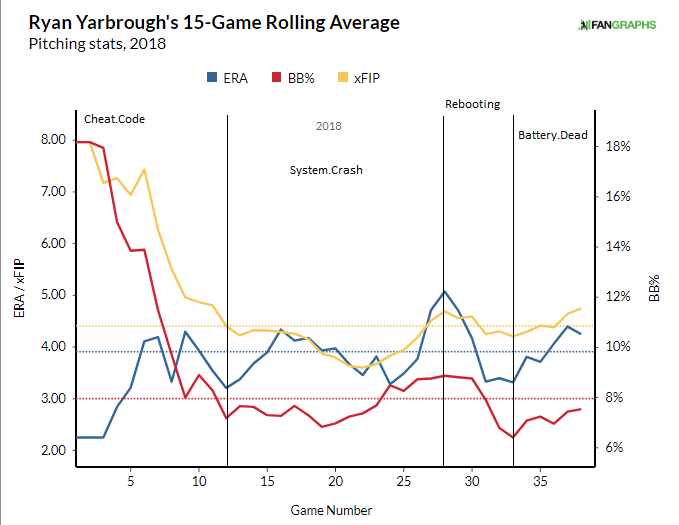
Keeping in mind that this was Yarbrough’s first year in the bigs, these progressions and regressions make sense, in a general way. You can see a classic rookie pattern of success, followed by the league adjusting to him and then vice-versa, eventually running out of gas as the season closes. You can also see that after his initial success, Yarbrough didn’t really add much to your rotisserie fantasy team.
But there were other things beneath the surface affecting those results. Namely, dipping his slider in molasses and slicing off even more ticks on the radar gun from what was already one of the slowest slide pieces in the majors.
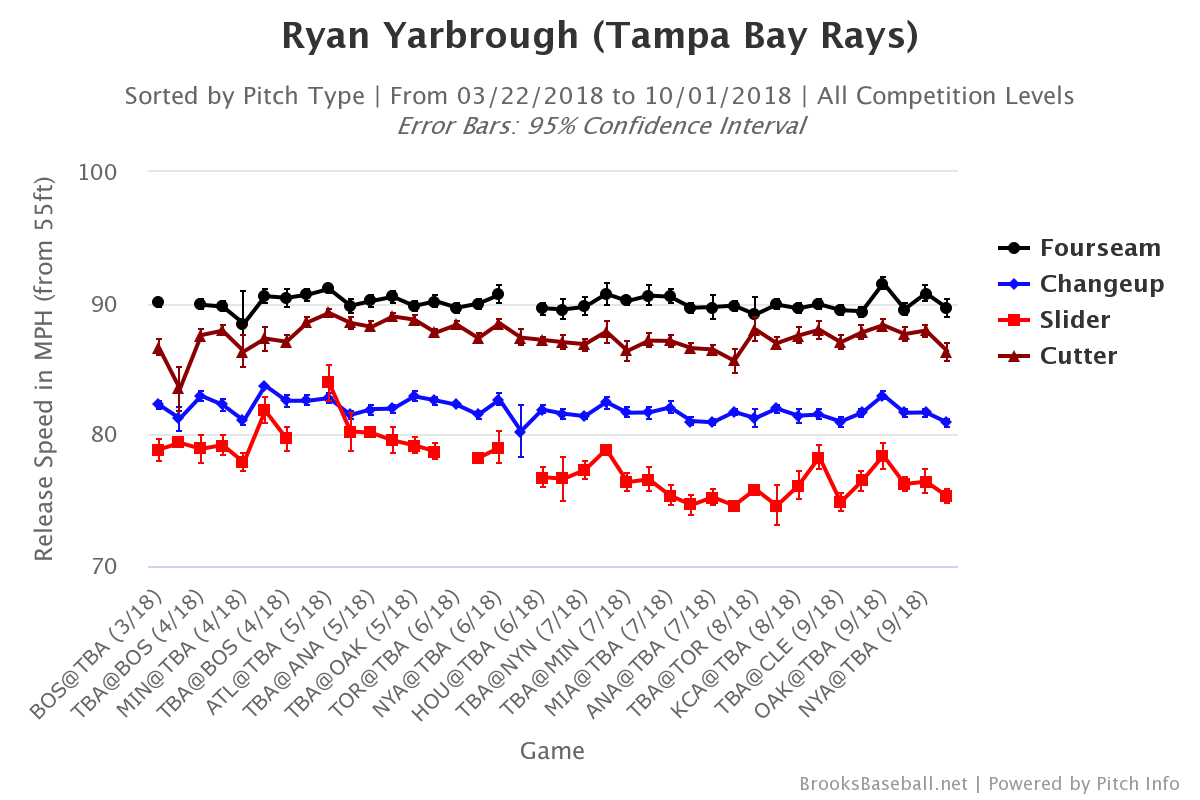
Here he is striking out Andrew Benintendi with a 78 MPH slider at the end of April in 2018:
https://gfycat.com/sanecoordinatedeskimodog
And here’s Yarbrough getting Rowdy Tellez on September 30, the slider clocking in at 73.5 MPH:
https://gfycat.com/fluidfatgrunion
Given we’re dealing with the Tampa Bay Rays, it’s no surprise this slowdown wasn’t some accidental flux in the matrix because as Daniel Russell laid out last August, Yarbrough started purposely slowing down his slider in order to give it more sweeping action, while keeping it’s vertical movement the same. Along with the slower speeds, he also began upping it’s usage, especially to left-handed batters, as he had surprisingly struggled against same-handed batters. With that in mind, we can now add more context to the fluctuations in Yarbrough’s 2018, seeing a rookie pitcher dealing not only with changes in his role from game to game, but also a pitcher trying to address his issues midseason by trying to fix his pitches and pitch mix.
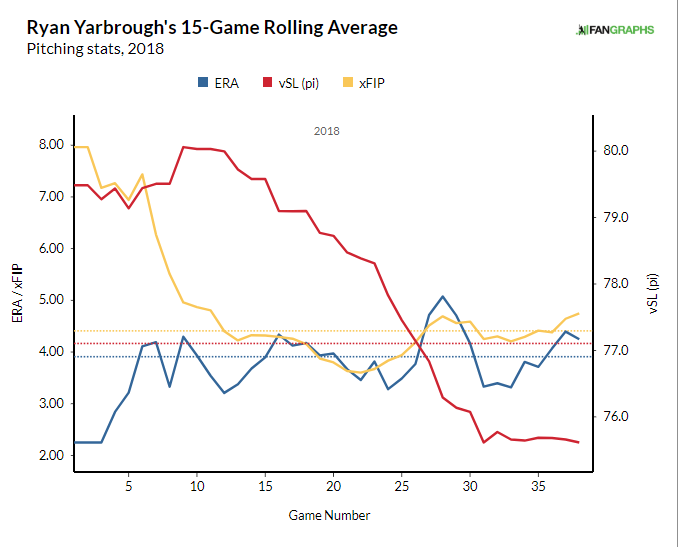
And so ended 2018 for Ryan Yarbrough, seen as nothing more than a fantasy fluke that Tampa Bay had used their bulk-reliever voodoo on to help him luck his way to 16 wins. There was no Ryan Yarbrough hype-train in the offseason because when you earn just $8.20 over 147 innings, a hype-train you merit not.
But someone forgot to tell Ryan Yarbrough that he was just a fluke.
Version 2.Brough
Rolling into 2019, the fantasy world cared not for Ryan Yarbrough and his 16 wins, rewarding him with a 538 ADP on NFBC. As well he should’ve been! I mean, we are dealing with Tampa Bay after all. Regardless of some sneaky success in the new “closer/follower” strategy, there was little point in drafting Yarbrough in any but the deepest leagues because who knew what his role would be, let alone if he’d be any good. And through five appearances in April, his performance justified all the hater-broughs, with Yarbrough getting knocked around:
| Version | G | GS | W | IP | ERA | BB% | WHIP | $ | $/IP |
|
2.Brough (4/1 – /24/19) |
5 | 0 | 2 | 16 | 8.10 | 5.6 | 1.21 | -0.5 | -0.03 |
Going a little deeper, let’s look at the pitch-mix that the 2019 version of Ryan Yarbrough started his season with. It’s a small sample of only 247 pitches in his five games, but it’s easy to see why maybe Yarbrough and the Rays thought that a change was needed:
Version 2.Brough: 4/1/19 – 4/24/19
| Pitch(Usage) | Brl% | wOBA | wOBAc | FIP | xFIP | K% | BB% | SwStr% | Chase% |
| 4Seam (44.5%) | 22.2 | .582 | .545 | 13.77 | 6.97 | 8.7 | 8.7 | 9.1 | 15.2 |
| Cutter (22.7%) | 0.0 | .400 | .296 | 2.33 | 5.62 | 16.7 | 5.6 | 12.5 | 44.0 |
| Slider (15.4%) | 0.0 | .000 | .034 | -0.39 | -0.03 | 57.1 | 0.0 | 10.5 | 19.0 |
| Change (17.4%) | 7.7 | .217 | .265 | 0.95 | 3.21 | 27.8 | 0.0 | 7.0 | 28.6 |
*Data courtesy of Alex Chamberlain’s Pitch Leaderboard
After being roughed up by the Kansas City Royals for seven runs on April 24, Yarbrough was sent back to the minors as it seemed that the sun had set on his time of usefulness. But Yarbrough dominated in Triple-A, going 2-0 in four games—three of which were starts—with a 2.14 ERA, 0.86 WHIP and a 32.1% K-BB%. And so he was summoned back to the majors on May 23.
Transitional.Brough
It was a different Yarbrough that came back, as the left-hander had once again begun purposely evolving. How was the slow slider, that had gotten even slower in 2018? Slooww-errrr. Of the 334 pitchers who’ve thrown at least 100 sliders this year, the lowest average velocity is Adam Cimber at 75.4 MPH. The slowest thrown by a starter is Dallas Keuchel at 78.4 MPH. Yarbrough is now sitting at 73.2 MPH.
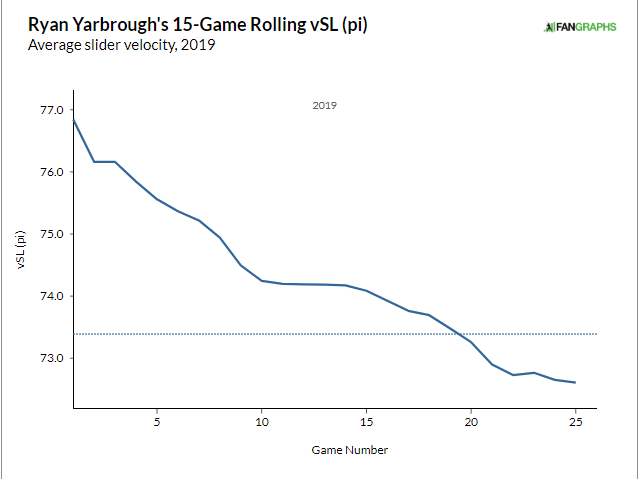
Besides the slower and more successful slider, Yarbrough came back changed in other ways, as well. Namely, the four-seamer has seen its usage phased way down, with the cutter instead taking center stage:
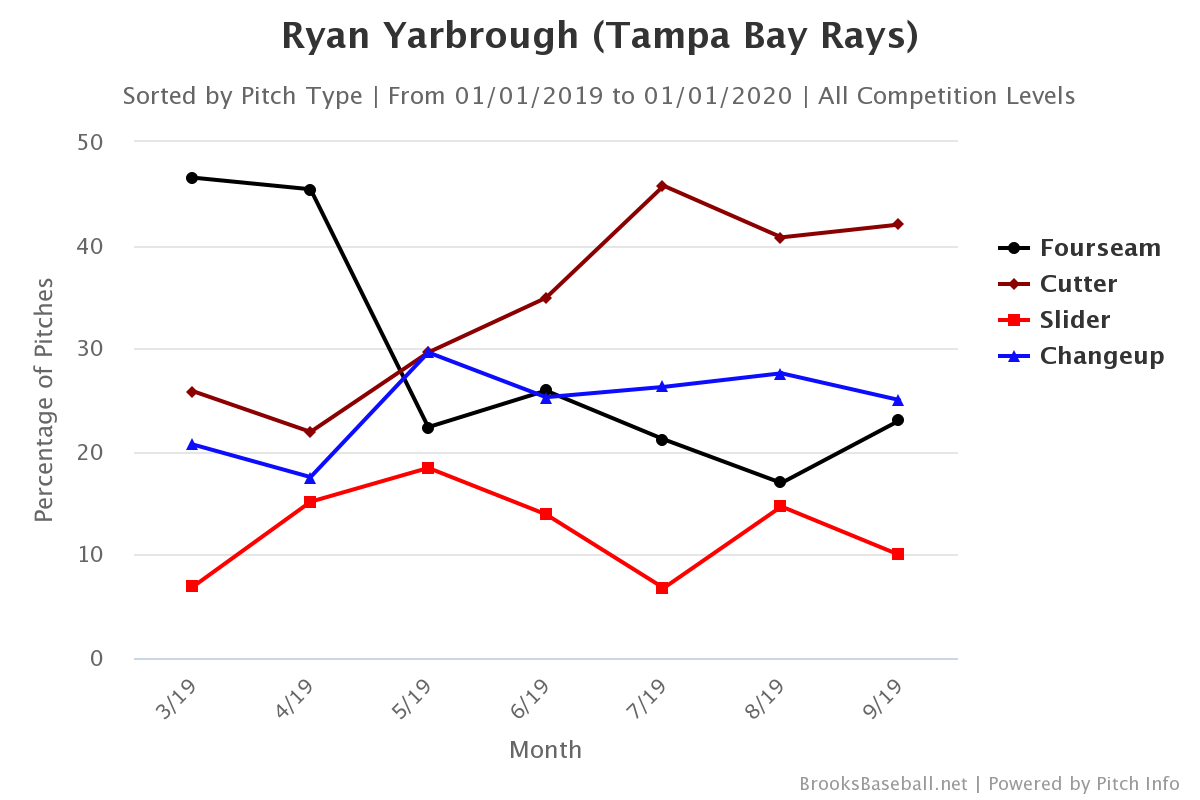
The four-seamer had gotten hammered in that first month and while the cutter wasn’t superb, it wouldn’t need to be great to best the four-seam cheese that he’d been lobbing up at 89 MPH. But this wasn’t the same cutter Yarbrough had thrown before because much like the evolution of his slider the year prior, his cutter was starting its own metamorphosis by also slowing down and achieving more sweeping action then it had before.
Here it is at 87 MPH in 2018:
https://gfycat.com/athleticplainafricanharrierhawk
And here it is at 84 MPH in 2019:
https://gfycat.com/shimmeringalarmedblowfish
This Yarbrough came back with slower pitches that had more movement but the mix still needed fine-tuning because his success upon returning fluctuated, as his first game back was solid, allowing two earned runs over 7 1/3 innings in a win at Cleveland, followed by four scoreless innings as a bulk reliever. Then a seven-run hiccup as a traditional starter happened, but that was followed by allowing just one earned run in 7 2/3 innings at Boston. Up and down, up and down. But after then giving up five runs in six innings to the Angels, this transitional Yarbrough really started to shine through, with the left-hander dominating through the All-Star break and into August. Even with the two rough outings, Yarbrough was bringing a lot of value to fantasy teams through the summer months:
| Version | G | GS | W | IP | ERA | BB% | WHIP | $ | $/IP |
|
Transitional.Brough (5/23/19 – 8/6/19) |
14 | 5 | 8 | 73.1 | 2.95 | 3.2 | 0.87 | 13.0 | 0.18 |
The most important number in that line may be the minuscule 3.2% walk-rate that he was carrying. Remember that the best versions of Yarbrough in 2018 carried decreasing walk-rates with them and even the version that had been sent down in May had kept the tiny rate, carrying only a 5.6% rate in those first five appearances. This isn’t some fluke because all TransitionalBrough was doing was continuing his work of the past year:
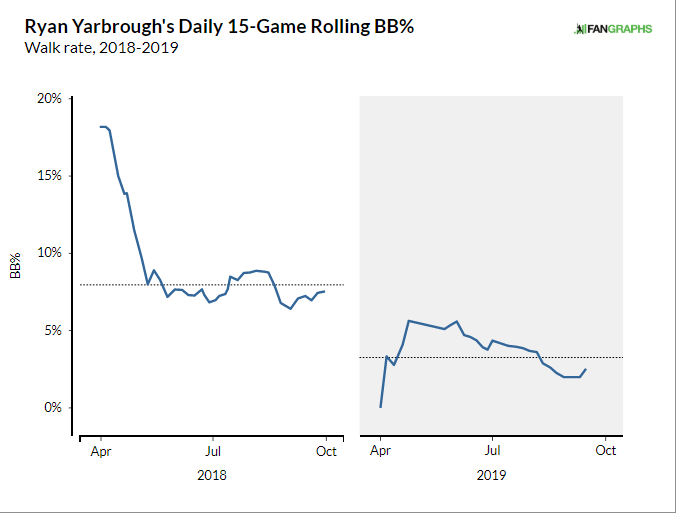
But as they say, the devil’s in the pitch-splits, because after those first three appearances, Yarbrough started to settle in a new, consistent plan of attack to the different sides, and getting much better results. Here’s how he’s attacked right-handed in 2019, with the yellow line marking his June 13 start against the Angels (6 IP, 5 ER):
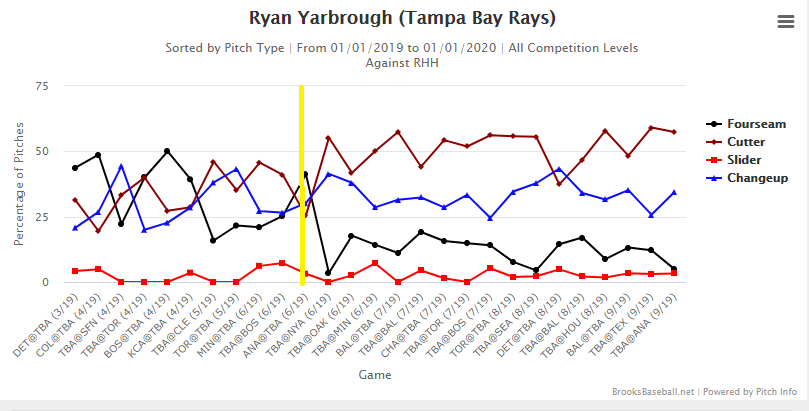
And here he is against left-handed batters:

There isn’t anything too crazy going on against the lefties, with Yarbrough only swapping out some of his slow-slider for more fastballs. But against right-handed batters, the change has been stark since getting roughed up on June 13, with the use of his four-seam falling off of a cliff and being replaced by the slow-cutter. And the results of this change?
Yarbrough didn’t just flip a switch on his pitch mix, he turned his hat around like Lincoln Hawk and started pitching like a machine made of trucks:
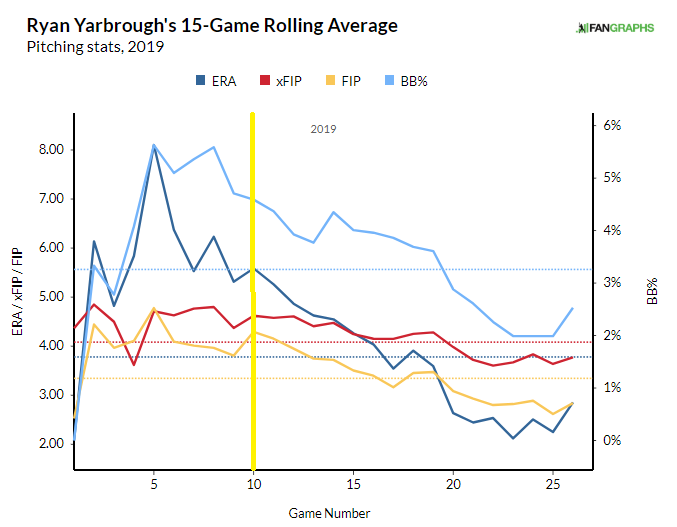
With a new pitch mix developing following the Angels start, the Tampa Bay reliever started lighting fools up, going 5-0 with a 1.94 ERA over 41 2/3 innings with a 0.82 WHIP and a .195 average against. But how ’bout that fantasy life? Going back to the chart before, our transitional Yarbrough earned $13 from May 23 to August 6, at a rate of $0.18/inning. Which seems inconsequential when compared to the top-five earners over that period, who were all in the $25 – $30 range. How did our hero and his meager $13 ended up?
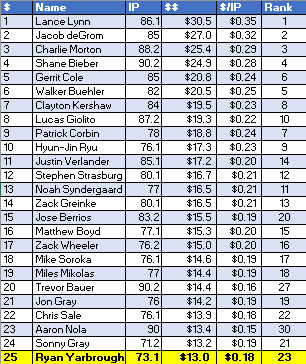
Startup.Brough
But even as he had seen increasing success both in the real and fantasy worlds, Yarbrough being used as a traditional starter in only one of nine games—after a stretch of starts that were mostly mediocre on the whole—made the narrative pretty obvious. Tampa wasn’t going to use Yarbrough as a permanent member of the five-man rotation, they would continue to use him as they best saw fit, right? Which certainly limits Yarbrough’s value in fantasy for the future because who wants to guess on what Tampa Bay trickery will be afoot whenever it comes to draft day?
But then on August 11, Yarbrough got the start for only the second time in ten games, with Tampa seeing injuries to Blake Snell and Yonny Chirinos. Then he started another. And another. And has now started seven games in a row, after never having started three games in a row in his career. No opener, no Tampa Bay shenanigans. Just a starter. And that first game was a near-masterpiece, as Yarbrough came within one out of his first career shutout, ultimately going 8 2/3 innings and allowing just three hits and no runs, while walking none and striking out eight.
He has remained very good as a starter but has come back to earth lately, including his last start where he gave up six runs in five innings, once again to the Angels. But even giving up 13 runs in his last three starts, Yarbrough still has a 3.53 ERA in these last seven games as a starter with a 0.90 WHIP. And a 2.4%(!) walk-rate in 43 1/3 innings. Which may tell the truest tale of Yarbrough’s development and stickiness: a walk rate that gets tinier and tinier no matter his other numbers.
| Version | G | GS | W | IP | ERA | BB% | WHIP | $ | $/IP |
| Startup.Brough
(8/11/19 – 9/15/19) |
7 | 7 | 1 | 43.1 | 3.53 | 2.4 | 0.90 | 10.90 | 0.25 |
Remember, this isn’t just about breaking down the evolution of Yarbrough from reliever to starter, it’s also about changing the perspective on just what his numbers have been worth from a fantasy view. Yarbrough’s numbers as a starter certainly don’t seem impressive, especially seeing he gave up six earned runs in his last time out, but let’s check again on how everyone else earned during this period:
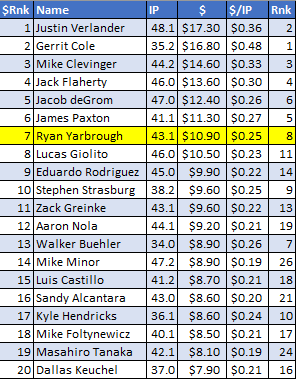
Please, please, please remember that this isn’t about saying that Ryan Yarbrough is Lucas Giolito or James Paxton. Those dollar-figures aren’t absolutes and this is just a snapshot of pitchers pitching at different times. What this should highlight is that maybe, Yarbrough’s boring numbers are more valuable then you thought.
Prime.Brough
Now that we’ve examined all the pieces, let’s look at the whole of Yarbrough since he came back from the minors in May:
| Version | G | GS | W | IP | ERA | BB% | WHIP | $ | $/IP |
| Prime.Brough
(5/23/19 – 9/15/19) |
21 | 12 | 9 | 116.2 | 3.16 | 2.9 | 0.88 | 23.8 | 0.205 |
And how does this production compare to that of his peers over that period?
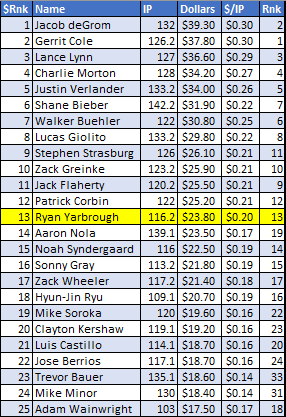
Pretty, pretty, good. Regardless of how much stock you put in dollar-values or sample-size, eventually we have to admit that Yarbrough’s been a much better fantasy asset than people have assumed, right? And can we also assume that Tampa didn’t just suddenly pull the plug on using him as a “follower” for no reason and start him for seven games in a row, just for fun? If the numbers keep telling us that Yarbrough has been a fantasy stud and if the Rays keep telling us that he’s a starter, then at what point do we listen?
Hypothetical.Brough
So there we have the four faces of Ryan Yarbrough in 2019: the Yarbrough that struggled early and was sent to the minors and the Yarbrough that came back with a new plan and a new cutter. We had the Yarbrough that settled into a groove over the summer, seemingly demanding with every appearance to make him a starter. And finally, it seems, we have Yarbrough the starter.
So, what about the future, Conan? Seeing that we are dealing with the Rays, anything could be possible for the remainder of 2019, but what about 2020? That value could fluctuate greatly based on his role, so the first question to answer is whether or not Tampa Bay will use him in a traditional starter role. But looking at his usage over his two years isn’t it reasonable to think that Tampa Bay may have already answered this? Even after periods of struggling as a starter and finding success as a reliever, the Rays always come back to try him as a starter again. And now—in the thick of a playoff race—they make him a traditional starter for seven starts in a row? And don’t think that they were forced into this position by injuries to starters Blake Snell and Yonny Chirinos, because what would preclude them from continuing to use training wheels (an opener) for Yarbrough’s appearances?
In 2020, the Rays rotation is settled at the top, with Blake Snell, Charlie Morton, and Tyler Glasnow. But for the final two spots, they’ll have their choice of Brendan McKay, Yonny Chirinos and Yarbrough—and also whatever new diamond in the rough they discover and shine up. Yarbrough certainly doesn’t have a spot in the rotation secured for 2020, but what matters is what Tampa Bay thinks of him and how much they’ll use him because innings are innings and Yarbrough has pitched 159 of them in 2019. Of course, 26 of those innings were in the minors, but for fantasy purposes, I’m more concerned about how many innings are possible out of Yarbrough in 2020; both what are possible in terms of what his body can give and also what is possible in terms of how many opportunities Tampa Bay is willing to give him. He pitched 147 innings in 2018 and has now logged 159 across all levels in 2019, with two starts remaining on the schedule, so ~170 IP seems about right for his season-ending total, a 15% increase over last year. If Tampa Bay believes in his ability as they seem to have shown, ~170 IP as a full member of the rotation or a non-traditional starter in 2020 doesn’t seem unreasonable.
Just for fun, let’s insert PrimeBrough’s $0.205 per-inning rate he earned over 117 innings into the 159 total innings he’s pitched total in 2019. In other words, how much would Yarbrough have earned if he had pitched for the whole year as he has since being recalled from the minors on May 23, and after evolving his pitch mix and cutter? How would that hypothetical $32.60 stack up this year?

Before you dismiss this list as poppycock because there’s no way that even a hypothetical Ryan Yarbrough would ever earn as much as Jack Flaherty this year, keep in mind that it took him a while to get going, with Flaherty carrying a 4.90 ERA through his first 90 innings.
Sidebar: Mike Clevinger has just been ridiculous.
Don’t mistake me, it’s not that I believe Ryan Yarbrough is going to be a top-20 pitcher next year or even have a rotation spot from jump street. But I believe in his fantasy value because I think Tampa Bay believes in his ability. So I’m ready to stick Yarbrough in a much higher bucket of value, a bucket that takes into account all of the subtle value that he can bring to your roster. A value that hasn’t yet been recognized going by the early results of the TGFBI #2EarlyMockDrafts, where he currently sits at a 192 ADP (#150 max). Which is a long way of saying that I’m definitely going to try and be too clever by half and draft him way too high…
I can’t wait for Tampa to make him their closer.
(Photo by Nick Wosika/Icon Sportswire)
